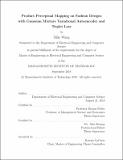Product perceptual mapping on fashion designs with Gaussian mixture variational autoencoder and triplet loss
Author(s)
Wang, Mike,M. Eng.Massachusetts Institute of Technology.
Download1098214449-MIT.pdf (1.737Mb)
Other Contributors
Massachusetts Institute of Technology. Department of Electrical Engineering and Computer Science.
Advisor
Drazen Prelec and Alex Burnap.
Terms of use
Metadata
Show full item recordAbstract
Product perceptual maps are visualizations of the perceptions of products by customers. They provide many advantages to businesses, such as identifying gaps in the market, understanding competition, and finding how new products fit into a market. Conventional product perceptual mapping methods exhibit limitations, particularly in capturing the highly nonlinear structure in product perceptual categories. Therefore, given only a set of images and triplet data representing product co-occurence by consumers, we propose and use a Gaussian mixture variational autoencoder (GMVAE) with triplet loss to create product embeddings. These product embeddings are then flattened into a 2D perceptual map able to be interpreted by human judgment. We test the GMVAE approach on three datasets: (1) a dataset of simple generated data; (2) the MNIST dataset, a dataset of handwritten digits; and (3) the Amazon Fashion dataset, a dataset of product images, product categories, and similar products. The GMVAE method is quantitatively evaluated on its ability to capture product "latent" categories, and qualitatively evaluated on the quality of its 2D perceptual maps compared with those produced by using a conventional perceptual mapping method. We find that across the experiments, the GMVAE method could reasonable capture "latent" perceptual product categories and is more effective than the conventional perceptual mapping baseline in correctly identifying and predicting latent product categories.
Description
This electronic version was submitted by the student author. The certified thesis is available in the Institute Archives and Special Collections. Thesis: M. Eng., Massachusetts Institute of Technology, Department of Electrical Engineering and Computer Science, 2018 Cataloged from student-submitted PDF version of thesis. Includes bibliographical references (pages 51-53).
Date issued
2018Department
Massachusetts Institute of Technology. Department of Electrical Engineering and Computer SciencePublisher
Massachusetts Institute of Technology
Keywords
Electrical Engineering and Computer Science.